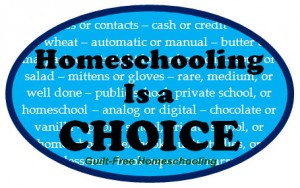Suppose your child wants a special cake for her birthday. What will you do? A few moms may be practiced in the fine art of baking the perfect cake from scratch, combining flour, sugar, and eggs in the correct proportions to rise to delicious heights without falling. Some moms will grab a boxed mix, whip it up, and top the resulting cake with ready-made frosting and colorful sprinkles. Other moms will simply stop by their favorite bakery and purchase a completed cake. In each case, the problem has been solved, and the birthday will be celebrated.
The same strategy can be applied to teaching in a homeschool setting. You can research topics yourself, much like looking for recipes in a cookbook or online or asking friends to share their favorites. You can collect a few do-it-yourself elements and put together your own curriculum, as with the mom who used the cake mix, canned frosting, and instant decorations. Or you can purchase an assortment of courses fully prepared by someone else, as in the case of the bakery cake.
I have met many people whose reaction to homeschooling is “You would have to be smart to do that!” Knowing what really goes on behind the scenes in homeschooling, my thought is “What is smart?” How intelligent does a person have to be to homeschool successfully? I do not have to know all the answers in order to be a good teacher, I just have to know where or how to find the answers. I do not have to be able to do something myself in order to be able to teach about it.
In my past educational experiences, I have had art instructors who effectively taught me about DaVinci and Rembrandt, but who could not duplicate the works of those masters themselves. I had English instructors who taught me about Shakespeare and Longfellow, but who had never written comparable works. I had history teachers who had done nothing memorable themselves and geography teachers who had never traveled the globe. My science teachers had made no remarkable scientific discoveries, and yet they were able to pass on accurate scientific knowledge. These successful instructors all relied to some degree on the resources and experiences of others.
A successful homeschool teacher is one who is able to impart the material to his or her students. The source of the material is not relevant if no one is able to learn from it. There are homeschool students whose curricula cost hundreds of dollars and students whose books are borrowed for free from the public library, and both learn equally well. There are homeschool teachers who write every page of their own lessons and teachers who read word-for-word from purchased, scripted manuals, and the students of both learn equally well.
If I had waited to begin homeschooling until I felt confident enough in my own knowledge and abilities that I could answer any question my students might ask, well, I would still be studying. In reality, I learned right along with my students. If I became hopelessly confused on some topic, the resources and experiences of others were nearby in the form of other homeschoolers, reference books, internet websites, or packaged lessons. When we encountered an unfamiliar word, we consulted the dictionary together. When we stumbled over a math problem, we worked it out together. When we were stumped by a reference to an exotic location, we leafed through the atlas or did a quick “Google” search together. The bonds created through learning together taught my students more than just new information. My students saw first-hand that learning can be an enjoyable and profitable, life-long process.
If you are intrigued by homeschooling, but feel you may not be smart enough, I encourage you to give it a try. You can supplement your knowledge through the materials you choose, increasing your teaching staff from one (just you) to dozens or even hundreds of experienced and qualified tutors (the authors whose works you consult).
If you currently use pre-packaged curriculum and would like to try your hand at creating a lesson on your own, go ahead and give it a try. There is no Official Omnipotent Homeschooling Rule Book that states you must always continue using the same method with which you started. If you currently are writing all of your own lessons, but find yourself so overwhelmed by recent developments in life that you would really like to try an all-in-one package, go ahead and give it a try. There is no Official Omnipotent Homeschooling Rule Book that states you must always continue using the same method with which you started. That non-existent Official Omnipotent Homeschooling Rule Book also does not prevent you from switching back to your original choices if you find you really prefer them. Variety is the spice of life, and flexibility is the blessing of homeschooling. Take a break, take a chance, and watch the learning continue.
If you are able to create your own lessons out of thin air, God bless you. If you prefer to use pre-prepared lessons purchased from an experienced publisher, God bless you, too. Guilt-Free Homeschooling frees you from the competition for Most Original Lesson Plan and allows you to use the method that works best for you and for your students. How smart do you have to be to be able to homeschool? Just smart enough to use what works.







 Guilt-Free Homeschooling is the creation of Carolyn Morrison and her daughter, Jennifer Leonhard. After serious disappointments with public school, Carolyn spent the next 11 years homeschooling her two children, from elementary to high school graduation and college admission. Refusing to force new homeschooling families to re-invent the wheel, Carolyn and Jennifer now share their encouragement, support, tips, and tricks, filling their blog with "all the answers we were looking for as a new-to-homeschooling family" and making this website a valuable resource for parents, not just a daily journal. Guilt-Free Homeschooling -- Equipping Parents for Homeschooling Success!
Guilt-Free Homeschooling is the creation of Carolyn Morrison and her daughter, Jennifer Leonhard. After serious disappointments with public school, Carolyn spent the next 11 years homeschooling her two children, from elementary to high school graduation and college admission. Refusing to force new homeschooling families to re-invent the wheel, Carolyn and Jennifer now share their encouragement, support, tips, and tricks, filling their blog with "all the answers we were looking for as a new-to-homeschooling family" and making this website a valuable resource for parents, not just a daily journal. Guilt-Free Homeschooling -- Equipping Parents for Homeschooling Success!

Recent Comments